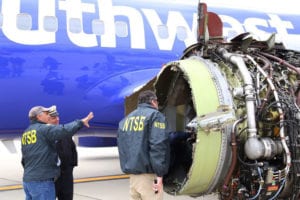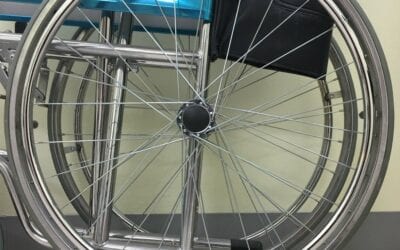Travelers can survive a plane crash
 Surviving a jetliner crash has been mentioned several times since the April emergency landing of Southwest Airlines, flight 1380, Many air travelers have asked if its passengers could have survived if the plane crashed. Fortunately, no one knows for sure. Captain Tammie Jo Shults, a former U.S. Navy pilot, landed the crippled aircraft safely. Unfortunately, one passenger, who was partially sucked out of a smashed window during the flight, died.
Surviving a jetliner crash has been mentioned several times since the April emergency landing of Southwest Airlines, flight 1380, Many air travelers have asked if its passengers could have survived if the plane crashed. Fortunately, no one knows for sure. Captain Tammie Jo Shults, a former U.S. Navy pilot, landed the crippled aircraft safely. Unfortunately, one passenger, who was partially sucked out of a smashed window during the flight, died.
U.S. commercial aircraft accident survival rates are higher than most air travelers realize. According to National Transportation Safety Board (NTSB) statistics, between 1983 and 2017, 56,695 passengers and crew flew on planes which had accidents, and 53,730 survived. That’s a 94.8 percent survival rate.
Of the 50 most serious accidents during those years, 4,048 passengers and crew survived out of the 5947 on those flights, a 68 percent survival rate. Included in that list is the Pan Am Lockerbie bombing and the aircraft hijacked on 9/11.
While it’s highly unlikely you’ll ever be on a commercial flight involved in an accident, there are things you can do to improve your survivability if one occurs.
Most people want to sit as far to the front of the plane as their budget will permit, but according to a study that examined U.S. commercial jet crashes from 1971 through 2006, in which there were fatalities while others survived, you’re safer in the back of the plane. The study concluded that those sitting closest to an aircraft’s tail have about a 40 percent better chance of surviving than those in the first few front rows.
Sitting within five rows of any aircraft exit can improve your chance of survival. After reviewing more than 100 crashes and interviewing passengers, a British safety expert concluded that if you’re within five rows of an exit you should be able to safely escape from a burning plane. Beyond that range, your chances of survival drop. In addition, passengers in aisle seats have a higher survival rate than those in middle and window seats.
What you wear can help you safely escape from a crash.
Wear shoes or leather sneakers. Don’t wear high heels, sandals or flip-flops. They make it hard to move quickly and safely within wreckage. Loose or elaborate clothing can snag on obstacles, especially when damaged. Wear clothing made primarily from natural fibers. Synthetic fibers and blends with a high percentage of synthetics can melt on your skin in a fire, causing serious burns.
Wear long pants and long sleeved shirts to help protect you if you have to slide down a wing or evacuation slide. Don’t wear shorts, a skirt or dress. I was in a plane which had an emergency landing. I learned the hard way to not wear shorts. I suffered friction burns going down the evacuation slide.
The moment you board your flight, devise an emergency escape plan. Count the rows from your seat to the two closest exits, fore and aft. That way, if smoke fills the plane, obscuring your sight, or fire blocks your exit in one direction, you’ll still know where to escape. You can count rows by feel as you pass them.
Read the safety information card at your seat and pay attention to the preflight safety speech. Every plane is a bit different, so it’s a good idea to learn about a plane in which you’ve never flown or refresh your memory.
Stay alert during and just after takeoff, and from about 10 minutes before and during landing. About 80 percent of accidents occur during those times. Keep your shoes on, don’t put on a face mask, earplugs, or earphones during those times.
If you’re in an emergency and alerted to prepare for a crash landing, stay calm. The odds are with you.
Remember your safety plan. Tighten your seat belt as much as possible. Remove any pencils, pens and sharp objects from your clothes. Put your dentures in a safe place as well as your glasses, if any.
If you have time, and it’s cold outside, put on your sweater or coat. Put any medicines you might need in your pockets. Cover your head if you can, and brace yourself in your seat, as per your flight crew’s instructions.
If the plane crashes, and once it comes to a stop, get out as fast as you can. Don’t wait to be told what to do by the flight attendants. They might be dazed or injured and can’t give directions.
Don’t take anything with you. Keep your hands free to maintain your balance while stepping over debris and luggage, or if pushed by panicking passengers. Don’t ever crawl on the floor to avoid smoke, as you might be trampled.
Once out of the plane, get as far from the crash as you can. The fuel left in the plane’s tanks could ignite and cause an explosion. If you see something to shield you, get behind it as long as it’s not too close to the plane. When planes explode, thousands of fragments can fly in all directions and be fatal.
In the event of a crash, these suggestions work. Stay calm. Stay alert. Follow flight crew instructions. Exit the plane quickly, then get away from it. Most passengers walk away safely from crashes and other emergencies.
(Image courtesy of the NTSB)
After many years working in corporate America as a chemical engineer, executive and eventually CFO of a multinational manufacturer, Ned founded a tech consulting company and later restarted NSL Photography, his photography business. Before entering the corporate world, Ned worked as a Public Health Engineer for the Philadelphia Department of Public Health. As a well known corporate, travel and wildlife photographer, Ned travels the world writing about travel and photography, as well as running photography workshops, seminars and photowalks. Visit Ned’s Photography Blog and Galleries.



